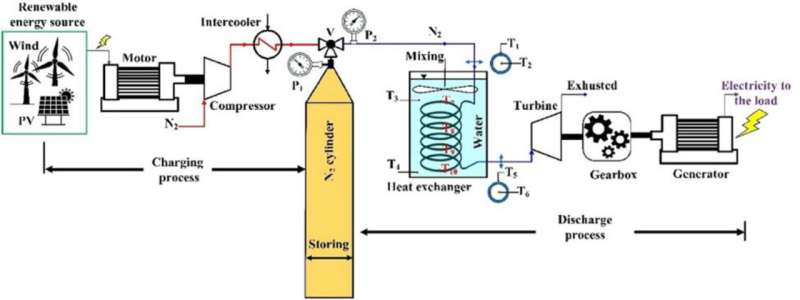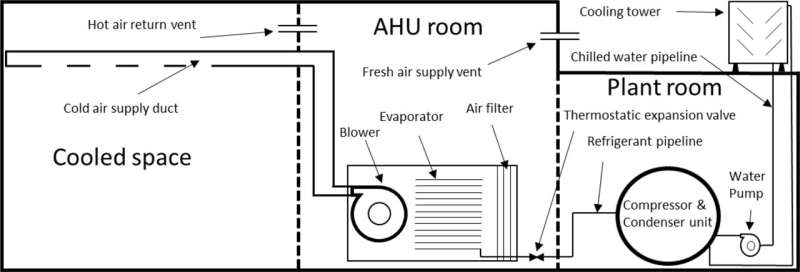
A group of scientists have discovered a new application to generate and store chilled water to reduce the impact of air conditioning on the environment, reduce energy consumption, and lower dependence on fossil fuels.
The new scientific breakthrough, once industrialized, is certain to be good news for more than 70,000 delegates taking part in the United Nations’ largest annual climate conference convened in the United Arab Emirates and attended by many world leaders.
The scientists say they arrived at their novel approach following extensive research and development on compressed air energy storage techniques, particularly the success of a medium scale laboratory-based system they have designed to boost the practical implications of their study.
The study, published in the International Journal of Thermofluids, has already been noted by a major UAE’s oil enterprise, the Sharjah National Oil Corporation (SNOC). The scientists expressed their optimism about the practical implications of their research, stemming from the success of their laboratory experiments.

The study, the authors write, focuses “on the potential of using expansion cooling, which is defined in conjunction with cooling effects generated during the expansion process of a gas.” The interest in such cooling technology stems from the double benefit of utilizing a large-scale compressed air energy storage (CAES) system that can also provide cooling via the expansion of air.
CAES is primarily used as a method of storing energy. However, the authors write that “there is an indirect relation in which CAES can be linked to cooling systems in certain scenarios, particularly in large-scale industrial settings or combined power plants. In a typical CAES system, excess energy from power generation is used to compress air and store it in underground caverns or high-pressure containers.”
CAES consequently manifests in reducing the electrical demand required for cooling applications. Such a concept is beneficial for hot climates, where most of the electrical demand is reserved for offsetting the cooling load, according to the study. The scientists find CAES friendly to the environment with better cooling impact and lower costs.
They remind their readers of the world’s thirst for energy, a situation which is mainly satisfied by the combustion of fossil fuels which account for most of the world’s emissions of greenhouse gases.
“The use of fossil fuels has resulted in enormous environmental issues, such as air pollution and climate change. Burning fossil fuels like coal, oil, and natural gas releases carbon dioxide (CO2) into the atmosphere, where CO2 is regarded as one of the primary greenhouse gases responsible for climate change,” they write.
The UAE is among the world’s 10 largest oil producers, pumping more than 3.7 million barrels of oil per day. In fact, the oil-rich Gulf region of the Middle East supplies more than 30% of the world’s total oil production of more than 100 million barrels per day.
But the region is one of the hottest in the world, with temperatures usually breaking the benchmark of 50° Celsius in the extended summer months. Vampire air conditioning appliances are kept on 24 hours per day throughout the year, exacerbating global warming which scientists blame for the current record-breaking weather system.
Almost all sorts of buildings in the Gulf, among them some of the world’s most known high rises, are mostly made of reinforced concrete and steel, with large panes of glass, which are no proof to the sweltering heat outside.
“Our research explores a novel approach to cool buildings in hot climates as an ancillary process to compressed air energy storage systems,” says the study’s lead investigator, Professor Abdul Hai Alami, Chairman of Sharjah University’s Department of Sustainable and Renewable Energy Engineering.
Such systems are traditionally employed to store energy from renewable sources like wind and solar power. However, the study, according to Prof. Al-Alami, discovers an additional application: generating chilled water for air conditioning.
The scientists’ main target for the application of their approach is the UAE, where air-conditioning consumes 60–70% of total energy demand which in terms of energy consumption per capita is among the highest in the world. However, the authors say their approach should not be confined to a single country as its implications can be suitable to cool buildings in hot climates anywhere.
The UAE is racing against time to meet a declared target of reducing overall energy consumption by 30% by 2030 at a time when statistics show energy demand to be surging by an average of 7.5% on a yearly basis. “In this context,” Prof. Alami points out, “our proposed setup serves as a thermal compressed air energy storage system, where heat has to be added to the expanding air before it enters turbomachinery.
“The heat added to the expansion stage of the compressed air energy storage system produces chilled water at temperatures as low as 5°C. We have built an experimental setup for the ancillary system with appropriate telemetric devices to measure the temporal temperature variation, which consequently can be used to estimate the available cooling capacity.”
The developed air-conditioning system was found to be financially and commercially sustainable with a promising potential of replacing the existing systems. Prof. Alami says, “We found that one ton of conventional cooling can be replaced with a 500-L (0.5 m3) air tank at 20 bar operating for an hour. Hence, this research shows that compressed air energy storage systems have the potential to revolutionize the way we cool buildings in hot climates.”
The study shows that the system leans on utilizing renewable energy sources to produce chilled water at lower temperatures, thereby reducing current reliance on traditional air conditioning systems that consume a lot of conventional energy and contribute to climate change.
Asked about the significance of the study and its practical implications, Prof. Alami says large-scale application of the project was feasible and he believed the interest the research has so far generated would lead to practical and useful implication to energy consumption in the UAE, the larger Middle East and even beyond.
“Our project offers a dual effect of energy storage through compressed air as well as producing a cooling effect during the expansion process. It is also worthy to note that during the compression stage of the stored air, and through proper thermal management, waste heat produced by the compressor can either be used in heating-based applications (water, air in winter), or resupply it to the air during the expansion process for enhancing the efficiency.
“Moreover, utilizing the cooling effect of air during the expansion process, and within the context of large-scale applications, falls into the proposed governmental policies, such as those in the UAE, where omitting conventional refrigerants is considered both a local and an international short-term goal.”
The authors document in their study what Prof. Alami describes as a “notable success” in medium scale laboratory-based systems, which they believe should help in the transition towards large-scale compressed air energy storage using depleted oil wells.
“Gaining expertise in design parameters and subcomponents, as well as coupling ancillary systems for cooling or heating will elevate the transition to large-scale systems and amplify their overall benefits,” adds Prof. Alami.
The primary goal of the project, as the authors outline in their study, is to develop a fully functional compressed air energy storage system, utilizing compressed air tanks, an air motor, a gear box, and a generator. They examine the effect of different parameters such as compression pressure, and compressed air tank configurations, as well as mechanical considerations such as gear box ratios and air motor ratings.
In our research, supported by a CASE experimental setup, we harness “wasted potential that is manifested in the cooling effect provided through the expansion process, as well as proving its benefit on the overall performance of the energy storage system, was one of the main targets.”
The authors mention various practical applications that can accompany the development of compressed air energy storage systems like the one they have developed.
Prof. Alami says, “Coupling these systems with pre-existing solar PV or wind energy systems at a large scale will aid in attenuating fluctuations in energy production, as well as provide a scalable solution with a long lifetime, contrary to electrochemical-based energy storage systems.
“Additionally, in hot and arid climates, utilizing the cooling effect produced during the expansion process will help in decreasing the overall electrical load imposed by cooling requirements, by producing chilled water that can be circulated in pre-existing cooling systems. Similarly, heating effects are produced during the compression stage of air into storage tanks (mediums) that can be used during winter season.”
Prof. Alami believes the project can revolutionize air conditioning systems. “Combining energy storage with air conditioning in the same setup resolves more than one problem; first, it introduces a robust energy storage solution to the energy mix, second it utilizes the thermal management of the air for air conditioning and finally this will automatically reduce the electrical load as air conditioning is one of the largest sectors of energy consumption in the UAE.”
More information:
Abdul Hai Alami et al, Expansion cooling prospects for large scale applications, International Journal of Thermofluids (2023). DOI: 10.1016/j.ijft.2023.100437
Citation:
Scientists develop environment-friendly and cost-effective approach to store energy and cool buildings in hot climates (2023, December 12)
retrieved 12 December 2023
from https://techxplore.com/news/2023-12-scientists-environment-friendly-cost-effective-approach-energy.html
This document is subject to copyright. Apart from any fair dealing for the purpose of private study or research, no
part may be reproduced without the written permission. The content is provided for information purposes only.
Stay connected with us on social media platform for instant update click here to join our Twitter, & Facebook
We are now on Telegram. Click here to join our channel (@TechiUpdate) and stay updated with the latest Technology headlines.
For all the latest Technology News Click Here
For the latest news and updates, follow us on Google News.
